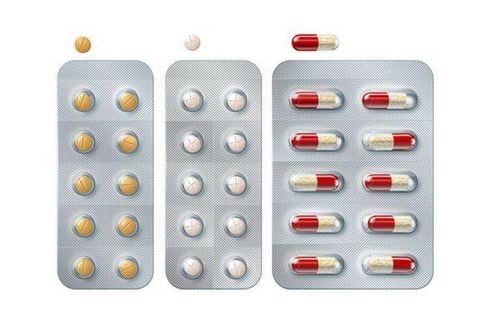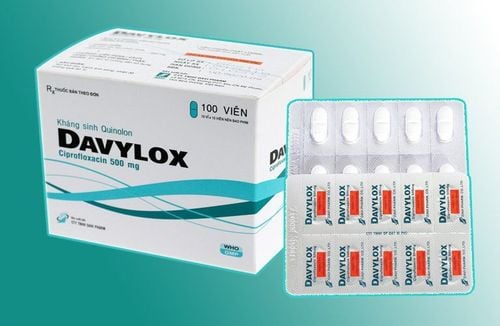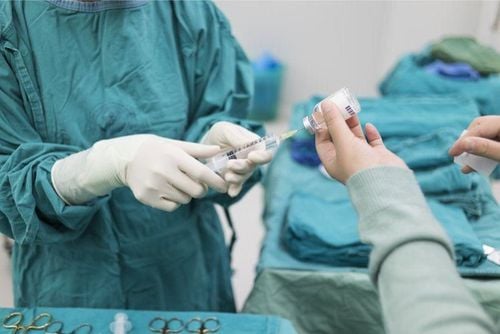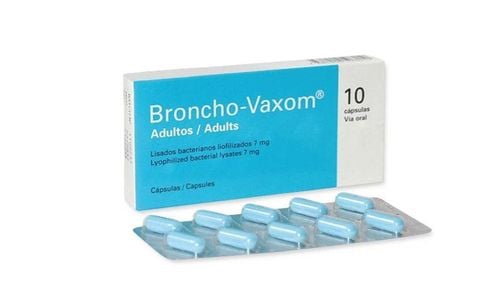This is an automatically translated article.
Maxef medicine 1g is prepared in the form of a powder for injection, with the main ingredient being Cefepim. The drug is used in the treatment of a number of bacterial infections such as pneumonia, urinary tract infections, intra-abdominal infections,...
1. What is Maxef 1g drug?
1 vial of Maxef 1g contains a mixture of Cefepim Hydrochloride and Arnigin, equivalent to 1g of Cefepim. Cefepim is a bactericidal antibiotic belonging to the betalactamin family, the 4th generation cephalosporin group. The drug's mechanism of action is inhibition of bacterial cell wall synthesis. Cefepim has a broad antibacterial spectrum including gram-positive and gram-negative bacteria. Cefepim is stable under hydrolysis by most beta-lactamases and rapidly penetrates gram-negative bacterial cells.
Indications for using Maxef 1g: Treatment of infections caused by strains of bacteria sensitive to the active ingredients of the drug:
Pneumonia, including cases related to sepsis; Complicated/uncomplicated urinary tract infections (including pyelonephritis); Uncomplicated skin and skin structure infections; Intra-abdominal infections causing complications; Febrile neutropenia (treatment empiric). To reduce the development of drug-resistant bacteria, and to maintain the effectiveness of cefepime and other antibiotics, cefepime should be used only for the treatment or prevention of infections caused by susceptible organisms. When information on bacterial culture and susceptibility is available, selection and adjustment of antibiotic therapy should be considered.
Contraindications to using Maxef 1g:
Patients with immediate hypersensitivity reactions to Cefepime or other cephalosporin antibiotics, penicillins, other beta-lactam antibiotics or Arginin.
2. Usage and dosage of Maxef 1g
How to use:
Intramuscular: When used intramuscularly, mix Cefepim powder with one of the suitable solvents. After reconstitution, each 1ml of solution contains approximately 280mg of Cefepim by volume of solvent and injected deep into the buttocks; Intravenous injection: When used intravenously, mix Cefepim powder with 10ml of one of the solvents for intravenous injection suitable for intravenous injection lasting for 3-5 minutes; Intravenous infusion: Administer Maxef 1g intravenously by intravenous infusion over approximately 30 minutes. The recommended concentration is from 1 to 40 mg/ml. The powder in the vial should be mixed with a suitable intravenous infusion solvent. After reconstitution, each 1 ml of solution contains approximately 20 mg or 10 mg of Cefepim according to the appropriate amount of solvent. Dosage:
Moderate to severe pneumonia: 1 - 2g IV x 2 times/day for 10 days; Mild to moderate complicated/uncomplicated urinary tract infections (including pyelonephritis): 0.5 - 1g IV/IM x 2 times/day for 7-10 days; Severe complicated/uncomplicated urinary tract infections (including pyelonephritis): 2g IV x 2 times/day for 10 days; Moderate to severe uncomplicated skin and skin structure infections: 2g IV x 2 times/day for 10 days; Complicated intra-abdominal infections (used in combination with metronidazole): 2g IV x 2 times/day, treatment for 7-10 days; Empiric treatment for febrile neutropenic patients: 2g IV x 3 times/day, for 7 days; Patients with impaired liver function: No need to change the dose; Patients with impaired renal function: Adjust according to the patient's creatinine clearance as follows: Clcr less than 60ml/min: Use the same initial dose in patients with normal renal function; Clcr 30 - 60ml/min: Dose in 24 hours as usual; Clcr 10 - 30ml/min: The dose in 24 hours is 50% of the usual dose; Clcr less than 10ml/min: Dosing in 24 hours is 25% of the usual dose; Patients on dialysis: Because 64% of Cefepim in the body is lost after 3 hours of dialysis, after each dialysis session, it is necessary to compensate by a dose equivalent to the initial dose; Patients on outpatient peritoneal dialysis: The usual dose is given every 48 hours. Overdose: Careful monitoring and supportive treatment should be given to patients receiving an overdose of Maxef 1g. In cases of renal failure and drug overdose, dialysis is recommended to remove Cefepim from the body.
3. Side effects of the drug Maxef 1g
When using Maxef 1g, patients may experience some side effects such as:
Clinical trials: Phlebitis, pain or inflammation at the site; skin rash; colitis (including pseudomembranous colitis), headache, fever, nausea, diarrhea, oral candidiasis, urticaria, itchy skin, vomiting, vaginitis; laboratory changes (positive Coomb's test - no hemolysis), hypophosphatemia, increased ALT and AST, eosinophilia, increased alkaline phosphatase, increased BUN, increased calcium, increased potassium, increased phosphorus, increased total bilirubin fraction, decreased calcium, decreased hematocrit, leukopenia, thrombocytopenia, neutropenia; Post-marketing experience: Encephalopathy (disordered consciousness including hallucinations, confusion, stupor and coma), seizures, myoclonus; anaphylaxis (including anaphylaxis, neutropenia, transient leukopenia, thrombocytopenia and agranulocytosis); Cephalosporin side effects: Stevens - Johnson syndrome, renal dysfunction, erythema multiforme, toxic epidermal necrolysis, aplastic anemia, toxic nephropathy, hemorrhage, hemolytic anemia, confusion liver dysfunction (including cholestasis), pancytopenia. When experiencing side effects of the drug Maxef 1g, the patient should immediately notify the doctor to receive advice on how to handle and respond appropriately.
4. Be careful when taking the drug Maxef 1g
Before starting treatment with Cefepime hydrochloride, it is necessary to determine if the patient has had a previous immediate hypersensitivity reaction to Cefepime, other cephalosporins. , penicillin or other drugs not. If Maxef is used for penicillin-sensitive patients, it should be used with caution because there is a risk of cross-allergy between beta-lactam antibiotics. If an allergic reaction occurs, Cefepim should be discontinued. Severe acute hypersensitivity reactions may require treatment with epinephrine and other emergency measures, including oxygen, corticosteroids, intravenous fluids, intravenous administration of antihistamines, pressor amines, open airway if clinically indicated; In patients with impaired renal function (creatinine clearance less than 60 ml/min), the dose of cefepime should be adjusted to accommodate its slower renal elimination. Because prolonged and elevated serum antibiotic concentrations may occur with usual dosing in patients with renal impairment or conditions that compromise renal function, a reduction in maintenance dose is required when cefepime is administered to patients with renal failure. this patient. The next dose should be determined based on the degree of renal impairment, the severity of the infection, the susceptibility of the causative organism; The risk of pseudomembranous colitis reported with nearly all antibiotics, including cefepime, can range from mild to life-threatening. Therefore, the diagnosis of this disease should be considered in patients with diarrhea following antibiotic administration; Treatment with antibiotics alters the microbiome of the colon, which may allow overgrowth of clostridium. Many studies have shown that Clostridium difficile toxins are the leading cause of antibiotic-associated colitis; Once the diagnosis of pseudomembranous colitis is confirmed, appropriate therapeutic measures should be instituted. Mild cases usually respond to discontinuation of the drug. In moderate to severe cases, protein, water, and electrolytes should be supplemented, and treatment with a clinically effective antibiotic for Clostridium difficile colitis is recommended; Use of Cefepim in cases of indications for prophylaxis or for non-bacterial infections is unlikely to be effective for the patient, increasing the risk of developing drug-resistant strains of bacteria; As with other broad-spectrum antibiotics, long-term use of Cefepim may increase the number of non-susceptible organisms. The patient's condition should be re-evaluated. If superinfection occurs during treatment, appropriate alternative treatment should be used; Many cephalosporins, including cefepime, alter prothrombin activity. This is a risk factor in patients with hepatic and renal impairment and in patients receiving a prolonged course of antibiotics. Prothrombin time should be monitored in high-risk patients, using exogenous vitamin K if indicated; During treatment with Cefepim, the patient may have a positive direct Coomb test result; Cefepim should be used with caution in patients with a history of gastrointestinal disease, especially colitis; There are no adequate and well-controlled studies in the use of Cefepim in pregnant women. Maxef should only be used during pregnancy if absolutely necessary; Cefepim posts into breast milk in very low concentrations but caution should still be exercised when this drug is used in nursing women.
5. Drug interactions Maxef 1g
Some drug interactions of Maxef 1g include:
Careful monitoring of renal function is recommended when taking high doses of aminoglycosides with Cefepime because of the potential for increased nephrotoxicity and ototoxicity of aminoglycoside antibiotics. ; Concomitant use of cephalosporins (Cefepim is a cephalosporin) with potent diuretics such as furosemide may cause nephrotoxicity; Using Cefepim may give false-positive results in urine glucose tests if Clinitest tablets are used. Patients should carefully pay attention to the above issues during the use of Maxef 1g to ensure the best infection treatment effect and limit the encounter with unpredictable side effects.
Follow Vinmec International General Hospital website to get more health, nutrition and beauty information to protect the health of yourself and your loved ones in your family.
Please dial HOTLINE for more information or register for an appointment HERE. Download MyVinmec app to make appointments faster and to manage your bookings easily.













